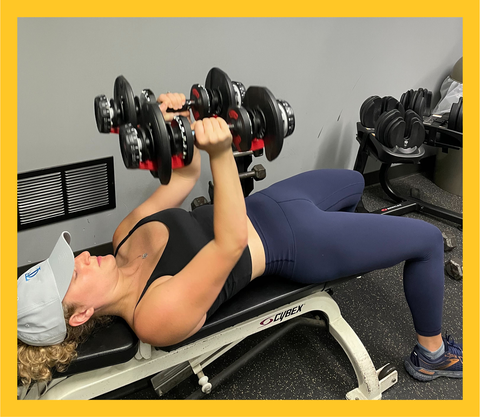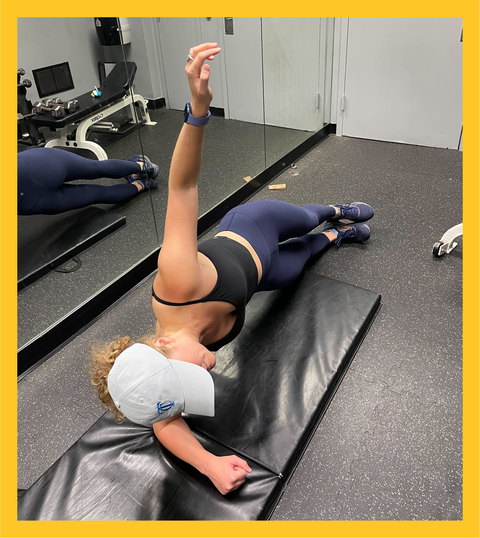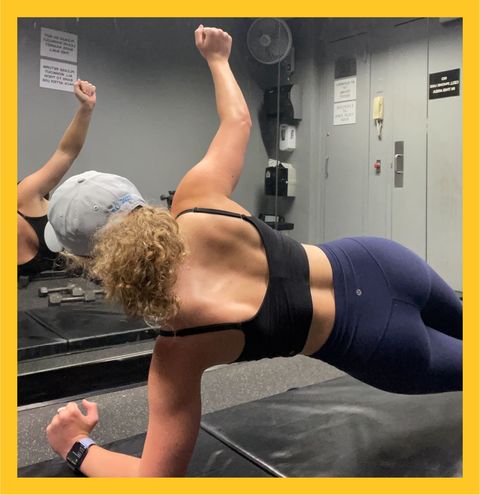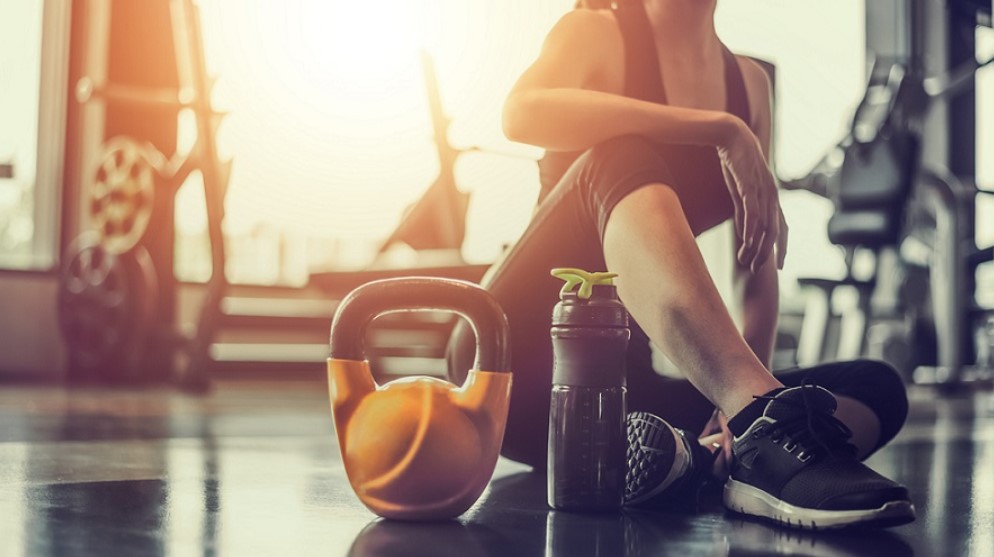‘I Did Natalie Portman’s ‘Thor’ Arm Workout For A Month’
I've always been self-conscious about my arms. I have broad shoulders and build muscle quickly, so I generally shied away from lifting weights in the past. An outdated refrain echoes in my head: You don't want to get *too* big and muscly. It didn't help that I was once told during a high school swim practice that I had "man shoulders"—whatever that means.
Still, when WH fitness editor Jennifer Nied asked if anyone wanted to try out Natalie Portman's arm workout from her movie Thor: Love and Thunder, in theaters July 8, I quickly volunteered. I surprised myself by how fast I said yes, as I had very limited knowledge of the movie, or Natalie's starring role as Thor. But in that moment, I wanted to try something different and revisit my relationship with training my upper body.
This was totally out of my wheelhouse. Running is my go-to exercise—but years of cross country, treadmill sprints, and looong races have taken a toll on my knees. I knew I needed to find new ways to move and make my body stronger. Why not try an A-lister's workout?
This content is imported from embed-name. You may be able to find the same content in another format, or you may be able to find more information, at their web site.
Once I got the training regimen from Natalie's trainer Naomi Pendergast, CPT, director of RPX fitness, it was just Natalie Portman and me, grinding our planks, Arnold presses, and more for three days a week. At least that's what I imagined in my head. (Spoiler: Building Marvel-worthy arms is so much more than biceps curls.) Here's how the 30 days of *intense* arm-strength training went and what I learned along the way.
The Thor Arm Workout, From Natalie's Trainer
Let's start with the basics. And, yes, this is ~the same~ workout Natalie did with her trainer to build muscles and prep for stunts in her Marvel role. "Our typical weekly routine would consist of three strength training sessions a week and two sessions of mobility, agility, and stability work," Pendergast tells me.
"Starting five months before shooting gave us the opportunity to make sure Natalie's body was well conditioned before we upped the weights to build muscle bulk," says Pendergast. "Consistency is the most important thing in changing your shape and reaching your goals." (Fun fact: Pendergast says Natalie's an avid runner, so we had that in common.)
And Natalie was very determined. "I was lucky because Natalie is an extremely focused, hard working, and determined person so she turned up every day and gave 100 percent," Pendergast says.
Here's the exact arm routine Pendergast programmed for Natalie to hit her goal Marvel physique. It includes four parts: an upper bod warm-up, arm strength combos, cardio bursts, and a core circuit.
Upper-body warmup:
30 seconds marching arms
30 seconds lat stretch
30 seconds beast crawl
10 repetitions roll down walk outs
25 repetitions power band kneeling reverse fly
Arm Strength Workout: (rest for 90 seconds between sets)
Off-set push up followed by a 1 minute elbow plank (4 sets of 10 reps)
Straight arm raise with palms up followed by 1 minute reverse plank (4 sets of 20 reps)
Dumbbell Arnold press followed by a 1 minute side plank (4 sets of 10 reps)
Dumbbell bicep curl followed by a power band kneeling rotation (4 sets of 12 reps)
Dumbbell tricep press followed by 1 minute squat jump (4 sets of 12 reps)
Cardio: 2 minutes boxing + 1 minute skipping (complete 3 rounds with 90 seconds rest in between)
Core circuit:
Basic abdominal crunch, feet down (1 set of 20 reps)
Abdominal crunch, feet up (1 set of 20 reps)
Abdominal crunch with a twist (1 set of 20 reps)
1 minute weighted overhead arm raises (3 sets)
The Journey
Week 1: I had to get creative with how to fit the workouts into my crazy schedule. Consistency off the bat was key.
I started doing Natalie's routine in mid-May, and I was out of town almost every weekend for various events—a college reunion, my brother's graduation, a wedding in Ireland, the list goes on. So, I had to get creative with my workouts, whether that was miming the jump rope sections, adjusting the weights, or wandering my way through hotels to find their tiny workout rooms.
The first day of the routine was hard. And I mean really hard. Training for a Marvel role is no joke. I followed all the directions as precisely as possible, and it took me a whopping hour and 17 minutes to get through all the circuits. The first round of push-ups and one-minute planks left me shaking, and I collapsed on my mat every time the timer went off, dreading the next round.
I started using 10-pound weights and graduated to using 12-pound weights for the Arnold presses and bicep curls. Pendergast suggested resting for 90 seconds between each set, but I actually found that I didn't always need this long to recover and often took 60-second breaks.
The first few workout sessions, I spent a lot of time checking my phone to make sure I was doing everything exactly right, and the whole thing seemed to take forever. I was exhausted at the end of each set, and my back sometimes hurt (I learned to stretch more and worked on my form).
Week 2: The workouts started to feel easier, and I had enough energy leftover for my beloved cardio.
It didn't take long before all the exercises began to feel a little easier. Well, almost all of them. The straight arm raises continued to be a challenge. I had to adjust my weights and could never quite make it to 20 reps without taking a break.
The four rounds of one-minute squat jumps left me hands-above-my-head gasping for air. After a particularly exhausting round of squat jumps, I began counting to help me mark how much time was passing, and realized I was doing roughly 55 per minute. To catch my breath and steady my heart rate, I'd walk in circles around the gym during the rest period.
I also started incorporating a very quick, short three-to-five minute treadmill fast run (anywhere from 8.5 to 9 mph) into the warmup to get my heart rate up, and found that it helped wake my body up better during early morning sessions so I could mentally and physically handle the moves to come.
I didn't stay still on my off days, either. I kept up some of my favorite regular workouts (read: cardio) like a long run on the West Side Highway or a 45-minute elliptical circuit. I did some yoga. I stretched, which felt incredible, and also was in line with Pendergast's guidance.
Week 3: My endurance improved and my competitive nature kicked in.
I really started noticing that my all-around stamina had improved. When I watched my form in the mirror, I noticed some definition, especially with my shoulders and biceps.
Knowing how hard Natalie worked definitely motivated me during especially busy days or sweaty combinations that seemed never-ending. I'll be the first to admit it: I'm very competitive. I also wanted to prove to myself that I could do it.
Week 4: I memorized the exercises and saw physical results.
A big benefit of following the same circuit each week was perfecting the moves. It took a while, but I finally didn't have to check my phone every time I switched exercises. On top of that, I increased the weights. Instead of grabbing the ten pound dumbbells, I went for the 12 pounds. The planks didn't hurt as much, either.
By day 30, I graduated to 15 pound weights for the triceps press. I saw big gains in my cardio endurance (yes, thanks to the strength training). The squat jumps didn't knock me out the way they used to.
My Biggest Takeaways
This challenge pushed me mentally and physically. More than a few times my alarm would go off in the mornings, and all I wanted to do was roll back over and sleep. I'm so glad I stuck with it. Here's what I learned about myself, exercising, and my body during those 30 days.
I didn't need to be perfect to reach my strength goals.
I usually work out every day, but I am certainly not used to working out for nearly an hour and a half each time I step in the gym. And as I struggled to wake up extra, extra early in the mornings before work, or attempted to fit in a nighttime sesh, I had to remind myself that unlike Natalie, this is not my full-time job. I gave myself permission to skip a few exercises or cut it short to, you know, make it to work on time or finish my laundry.
I'm a rule-follower, a planner, and a perfectionist, so that was tough. I probably missed a workout or two when life got in the way (I had to make it to a wedding one afternoon and I had to skip the last two circuits.) But I gave myself grace, keeping in mind I was doing my best. It wasn't about perfection, it was about committing to the challenge. And I still felt and saw a big difference after just 30 days.
Sharing my progress with friends and family helped keep me accountable.
I'd be lying if I said I always looked forward to the hardcore training sessions. Sometimes, I actually dreaded the long, tough routine. As cheesy as it sounds, I got through it thanks to accountability and support from my fam and friends.
My family really enjoyed following along with my progress. I am the only daughter in a family of all boys, and my brothers and dad loved asking about the workout. One of my brothers also thought I was doing the workouts with Natalie, and I am sure he was heartbroken when I corrected him.
I wanted to have new progress reports every time they checked in about my workouts. Skipping a sesh or quitting the routine altogether wasn't an option.
I learned a lot about my body—about how it moves, and what it needs.
My body didn't need long cardio sessions every single day. My knees thanked me for more off days. My lifting fears—getting bulky or big or developing whatever "man shoulders" are—never came true.
My body responded in ways I never expected to the new routine. In fact, I have definition in areas I struggle to tone (my tris). And I didn't just see a change in my arms, I felt it in my core, too. That's what dozens and dozens of body-shaking planks will do in a month.
The best part is, I feel really strong, and that feels so good. It's been years since I did real-deal strength training, and I've never done a trainer-programmed routine before.
Even now, I find myself gravitating toward those dumbbells. I definitely am not opting for the full 75-minutes arm circuits after a run, but I'm keeping some of the strength moves in my regular routine because I really, really love feeling so strong.
This content is created and maintained by a third party, and imported onto this page to help users provide their email addresses. You may be able to find more information about this and similar content at piano.io







:quality(70)/cloudfront-us-east-1.images.arcpublishing.com/tronc/WZGIWSRHQNAZ5B7LAEQTNUHSSI.JPG)